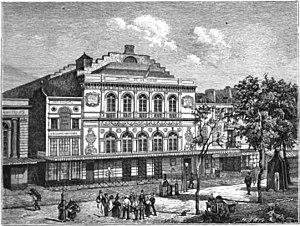Théâtre de Nicolet
| Théâtre de Nicolet (1759–1772) Grands-Danseurs du Roi (1772–1792) |
|

The Théâtre de la Gaîté's fourth and last theatre on the boulevard du Temple, used from 1835 to 1862
|
|
| Address | 58 boulevard du Temple, 11th arrondissement (post 1860) Paris |
|---|---|
| Coordinates | 48°52′00″N 2°21′55″E / 48.8667°N 2.3653°E |
| Capacity | 1,545 (1808 theatre) 1,800 (1835 theatre) |
| Construction | |
| Opened | 1759 (nearby, across the street) |
| Demolished | c. 1862 (4th theatre) |
| Rebuilt | 58 boulevard du Temple: 1762–4, 1808, 1835 |
The Théâtre de la Gaîté, a former Parisian theatre company, was founded in 1759 on the boulevard du Temple by the celebrated Parisian fair-grounds showman Jean-Baptiste Nicolet as the Théâtre de Nicolet, ou des Grands Danseurs. The company was invited to perform for the royal court of Louis XV in 1772 and thereafter took the name of Grands-Danseurs du Roi. However, with the fall of the monarchy and the founding of the First French Republic in 1792, the name was changed to the less politically risky Théâtre de la Gaîté. The company's theatre on the boulevard du Temple was replaced in 1764 and 1808, and again in 1835 due to a fire. As a result of Haussmann's renovation of Paris, the company relocated to a new theatre on the rue Papin in 1862, and the 1835 theatre (pictured) was subsequently demolished.
In 1759 a new Lieutenant General of Police, Antoine de Sartine, took office, and Jean-Baptiste Nicolet, an actor who specialized in playing the role of Harlequin, and one of the foremost producers of popular entertainments at the Parisian fairs, took the opportunity to obtain permission to begin performing in a rented theatre on the boulevard du Temple, although he also continued to present at the fairs until 1789. The boulevard, which was 30 meters in width, much greater than a typical Parisian street of the time, ran from the Porte Saint-Martin at the northern edge of the city to the Porte Saint-Antoine in the east. It had been created on top of defensive earthworks erected by Charles V in the 14th century and in 1668, during the reign of Louis XIV, turned into a promenade with four rows of trees. A popular spot, not least because its elevation afforded good views of the windmills of Montmartre and the countryside to the north of the city, it remained mostly unpaved until 1778. The French term boulevard actually derives from Middle Dutch bolwerc (English: bulwark).
...
Wikipedia
